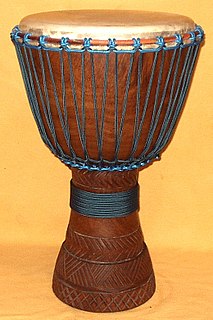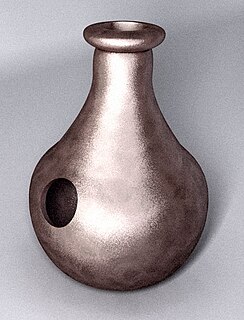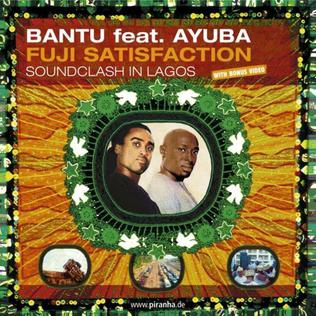
The drum is a member of the percussion group of musical instruments. In the Hornbostel-Sachs classification system, it is a membranophone. Drums consist of at least one membrane, called a drumhead or drum skin, that is stretched over a shell and struck, either directly with the player's hands, or with a percussion mallet, to produce sound. There is usually a resonant head on the underside of the drum. Other techniques have been used to cause drums to make sound, such as the thumb roll. Drums are the world's oldest and most ubiquitous musical instruments, and the basic design has remained virtually unchanged for thousands of years.
Given the vastness of the African continent, its music is diverse, with regions and nations having many distinct musical traditions. African music includes the genres amapiano, Jùjú, Fuji, Afrobeat, Highlife, Makossa, Kizomba, and others. The music and dance of the African diaspora, formed to varying degrees on African musical traditions, include American music like Dixieland jazz, blues, jazz, and many Caribbean genres, such as calypso and soca. Latin American music genres such as cumbia, conga, rumba, son cubano, salsa music, bomba, samba and zouk were founded on the music of enslaved Africans, and have in turn influenced African popular music.

The music of Nigeria includes many kinds of folk and popular music, styles of folk music are related to the multitudes of ethnic groups in the country, each with their own techniques, instruments, and songs. Little is known about the country's music history prior to European contact, although bronze carvings dating back to the 16th and 17th centuries have been found depicting musicians and their instruments. The country's most internationally renowned genres are Indigenous, Apala, Ogene, Fuji, Jùjú, Afrobeat, Afrobeats, Igbo Highlife, Afro-juju, Waka, Igbo rap, Yo-pop, Gospel. The largest ethnic groups are the Igbo, Hausa and Yoruba. Traditional music from Nigeria and throughout Africa is almost always functional; in other words, it is performed to mark a ritual such as the wedding or funeral and not to achieve artistic goals. Although some Nigerians, especially children and the elderly, play instruments for their own amusement, solo performance is otherwise rare. Music is closely linked to agriculture, and there are restrictions on, for example, which instruments can be played during different parts of the planting season.

A djembe or jembe is a rope-tuned skin-covered goblet drum played with bare hands, originally from West Africa. According to the Bambara people in Mali, the name of the djembe comes from the saying "Anke djé, anke bé" which translates to "everyone gather together in peace" and defines the drum's purpose. In the Bambara language, "djé" is the verb for "gather" and "bé" translates as "peace."

Yoruba is a language spoken in West Africa, primarily in Southwestern and Central Nigeria. It is spoken by the ethnic Yoruba people. The number of Yoruba speakers is roughly 45 million, plus about 2 million second-language speakers. As a pluricentric language, it is primarily spoken in a dialectal area spanning Nigeria and Benin with smaller migrated communities in Côte d'Ivoire, Sierra Leone and The Gambia.

The conga, also known as tumbadora, is a tall, narrow, single-headed drum from Cuba. Congas are staved like barrels and classified into three types: quinto, tres dos or tres golpes (middle), and tumba or salidor (lowest). Congas were originally used in Afro-Cuban music genres such as conga and rumba, where each drummer would play a single drum. Following numerous innovations in conga drumming and construction during the mid-20th century, as well as its internationalization, it became increasingly common for drummers to play two or three drums. Congas have become a popular instrument in many forms of Latin music such as son, descarga, Afro-Cuban jazz, salsa, songo, merengue and Latin rock.
Fújì is a popular Yoruba musical genre. It arose from the improvisational wéré music, also known as ajísari, a genre of music performed to wake Muslims before dawn during the Ramadan fasting season. Alhaji Sikiru Ayinde Barrister popularized wéré music during the 1950s and 60s and conceived the term "fújì" in an unusual way. According to Barrister, "I came up with it when I saw a poster at an airport, advertising the Mount Fuji, which is the highest peak in Japan." Fújì should not be mistaken for the Yorùbá words "fuja" or "faaji," which mean leisure or enjoyment.

Jùjú is a style of Yoruba popular music, derived from traditional Yoruba percussion. The name juju from the Yoruba word "juju" or "jiju" meaning "throwing" or "something being thrown". Juju music did not derive its name from juju, which is a form of magic and the use of magic objects, common in West Africa, Haiti, Cuba and other South American nations. It evolved in the 1900s in urban clubs across the countries, and was believed to have been created by Ababababaa Babatunde King, popularly known as Tunde King. The first jùjú recordings were by King and Ojoge Daniel in the 1920s, when King pioneered it. The lead and predominant instrument of jùjú is the Iya Ilu, talking drum.
Apala is a music genre originally developed by the Yoruba people of Nigeria, during the country's history as a colony of the British Empire. It is a percussion-based style that originated in the late 1930s. The rhythms of apala grew more complex over time, and have influenced the likes of Cuban music, whilst gaining popularity in Nigeria. It has grown less religious centered over time.

The music of West Africa has a significant history, and its varied sounds reflect the wide range of influences from the area's regions and historical periods.

The Batá drum is a double-headed drum shaped like an hourglass with one end larger than the other. The percussion instrument is still used for its original purpose as part of traditional religious activities among the Yoruba. Batá drums have been used in the religion known as Santería in Cuba since the 1800s, and in Puerto Rico and the United States since the 1950s. Today, they are also used for semi-religious musical entertainment in Nigeria and in secular, popular music. The early function of the batá was as a drum of different gods, of royalty, of ancestors and a drum of politicians, impacting all spheres of life in Yoruba land.

Yoruba music is the music of the Yoruba people of Nigeria, Togo, and Benin. It is perhaps best known for its extremely advanced drumming tradition, especially using the dundun hourglass tension drums. Yoruba folk music became perhaps the most prominent kind of West African music in Afro-Latin and Caribbean musical styles; it left an especially important influence on the music used in Santería practice and the music of Cuba. For a comprehensive discussion of Yoruba music, see Bode Omojola's book, Yoruba Music in the Twentieth Century.

Igbo music is the music of the Igbo people, who are indigenous to the southeastern part of Nigeria. The Igbo traditionally rely heavily on percussion instruments such as the drum and the gong, which are popular because of their innate ability to provide a diverse array of tempo, sound, and pitch. Igbo music is generally lively, upbeat, and spontaneous which creates a variety of sounds that enables the Igbo people to incorporate music into almost all the facets of their daily lives. Some very popular Igbo music styles are Igbo highlife, Igbo bongo, Odumodu.

The talking drum is an hourglass-shaped drum from West Africa, whose pitch can be regulated to mimic the tone and prosody of human speech. It has two drumheads connected by leather tension cords, which allow the player to change the pitch of the drum by squeezing the cords between their arm and body.
The agidigbo or ‘’’molo’’’ is a large traditional plucked lamellophone thumb piano used by the Yoruba people of Nigeria to play apala music.
Gbedu literally means "big drum" and is a percussion instrument traditionally used in ceremonial Yoruba music in Nigeria and Benin. More recently, the word has come to be used to describe forms of Nigerian Afrobeat and Hip Hop music.
Sakara music is a form of popular Nigerian music based in the traditions of Yoruba music. It mostly in the form of praise songs, that uses only traditional Yoruba instruments such as the solemn-sounding goje violin, and the small round sakara drum, which is similar to a tambourine and is beaten with a stick. Sakara music overlays the nasalized, melismatic vocals of Eastern Africa and Arabic on the traditional percussion instruments. The music is often brooding and philosophical in mood.

Sub-Saharan African music is characterised by a "strong rhythmic interest" that exhibits common characteristics in all regions of this vast territory, so that Arthur Morris Jones (1889–1980) has described the many local approaches as constituting one main system. C. K. Ladzekpo also affirms the profound homogeneity of approach. West African rhythmic techniques carried over the Atlantic were fundamental ingredients in various musical styles of the Americas: samba, forró, maracatu and coco in Brazil, Afro-Cuban music and Afro-American musical genres such as blues, jazz, rhythm & blues, funk, soul, reggae, hip hop, and rock and roll were thereby of immense importance in 20th century popular music. The drum is renowned throughout Africa.

Sulaimon Alao Adekunle popularly known by his stage name Ks1 Malaika is a Nigerian Fuji musician who started playing and performing music from an early age in a quranic school in the suburb of Lagos known as Agege and further paying his dues through Were before forming his first Fuji band in 1983 who also malaika Wasiu who

Fuji Satisfaction: Soundclash In Lagos is a studio album by BANTU. The album features vocal contributions by Nigerian Fuji musician Adewale Ayuba. It was recorded between April and December 2004 at various studios in Cologne, Berlin and Lagos, Nigeria. The album was released in June 2005 by Piranha Music. Producer Herb V produced the album by combining programmed beats and samples with Yoruba percussion instruments like the Sakara, Apala, Omele, Bata and Iya Ilu drums, Additional production and instrumentation was provided by the Berlin-based Afrobeat Academy Band. The Subject matter on Fuji Satisfaction deals with Pan Africanism, homophobia and Yoruba identity. The album marked a turning point for BANTU as it took them closer to their Yoruba roots. It also stretched conventional perception of Fuji music by fusing it with Hiphop, Dancehall, Afrobeat and Afrofunk elements. The album debuted at number 2 on the European World Music Charts. BANTU was awarded the Kora Awards in the categories "Best Group West Africa" and "Best Group Africa" for Fuji Satisfaction















